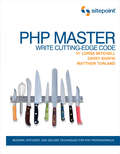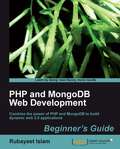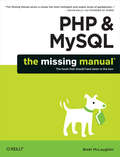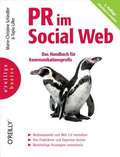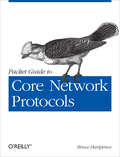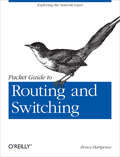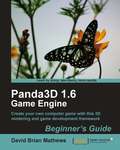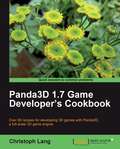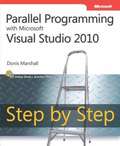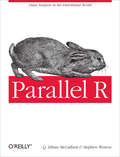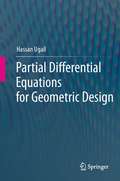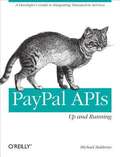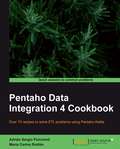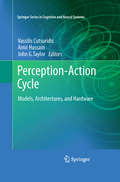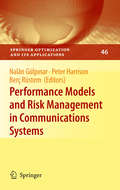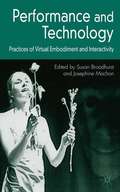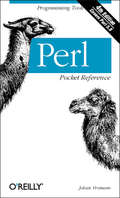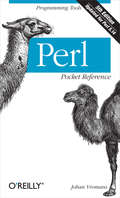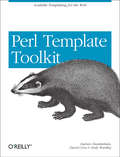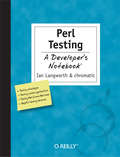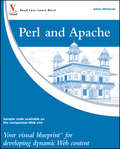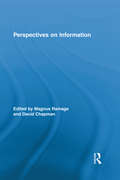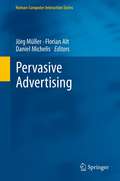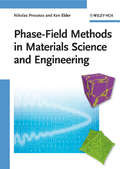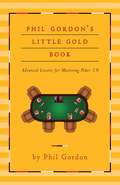- Table View
- List View
PHP Master: Write Cutting Edge Code
by Davey Shafik Lorna Mitchell Matthew TurlandPHP Master is tailor-made for the PHP developer who's serious about taking their server-side applications to the next level and who wants to really keep ahead of the game by adhering to best practice, employing the most effective object-oriented programming techniques, wrapping projects in layers of security and ensuring their code is doing its job perfectly.Create professional, dynamic applications according to an object-oriented programming blueprintLearn advanced performance evaluation techniques for maximum site efficiencyBrush up on the best testing methods to refine your code and keep your applications watertightProtect your site against attacks and vulnerabilities with the latest security systemsPlug in to some serious functionality with PHP's APIs and libraries
PHP and MongoDB Web Development Beginner’s Guide
by Rubayeet IslamThe book follows a "Code first, explain later" approach, using practical examples in PHP to demonstrate unique features of MongoDB. This book is packed with step-by-step instructions and practical examples, along with challenges to test and improve your knowledge. This book assumes that you are experienced in web application development using PHP, HTML, and CSS. Having working knowledge of using a relational database system such as MySQL will help you grasp some of the concepts quicker, but it is not strictly mandatory. No prior knowledge of MongoDB is required.
PHP and MySQL: The Missing Manual
by Brett Mclaughlin<p>If you can build websites with CSS and JavaScript, this book takes you to the next level—creating dynamic, database-driven websites with PHP and MySQL. Learn how to build a database, manage your content, and interact with users through queries and web forms. With step-by-step tutorials, real-world examples, and jargon-free explanations, you’ll soon discover the power of server-side programming.</p>
PR im Social Web (O'Reillys Basics)
by Marie-Christine Schindler Tapio LillerInteressante Zeiten für Kommunikationsprofis: Mit dem Erstarken des Social Web verändert sich das Verhältnis zwischen Unternehmen bzw. Agenturen und ihren Dialoggruppen - Transparenz und Austausch werden immer wichtiger. PR im Social Web zeigt, was das für die PR-Arbeit bedeutet. Die Autoren, selbst erfahrene PR-Profis, erläutern die veränderten Rahmenbedingungen und erklären, wie die einzelnen PR-Disziplinen und Unternehmensbereiche von Social Media profitieren können. Zahlreiche Fallstudien, Tipps und Checklisten erleichtern es Ihnen, das Gelesene auf Ihre eigenen Kommunikationsziele anzuwenden. Für die zweite Auflage wurde das Buch komplett aktualisiert und um Kapitel zu Nonprofit-PR und Erfolgsmessung ergänzt. Von der Medienarbeit bis zur Krisenkommunikation Die Medienarbeit wird durch Aktivitäten im Social Web bereichert - Blogger Relations, Monitoring, Issues Management und der Umgang mit Kritik und Krisen sind nur einige wichtige Stichworte. Corporate Publishing und Events Corporate Blogs und Podcasts bieten interessante Publikations- und Dialogmöglichkeiten, und Events erhalten über soziale Netzwerke und Livestreams eine deutlich größere Öffentlichkeit. Personalmarketing und Interne Kommunikation Vom Employer Branding über Recruiting bis zum Einsatz von Social Media im Unternehmen selbst - für die HR-Kommunikation bietet sich das Social Web mit seinen Dialogmöglichkeiten geradezu an. Kundenservice und Support Keine klassischen PR-Disziplinen, doch auch Kundenservice und Support werden durch die Social Media erheblich persönlicher und können so viel Positives zur öffentlichen Wahrnehmung eines Unternehmens beitragen. Wie sich der PR-Beruf ändert Vieles ist im Umbruch, davon sind auch die Aufgabenverteilung zwischen Unternehmen und Agenturen sowie das Berufsbild des PR-Profis selbst betroffen. NEU: Messbarkeit im Social Web: von KPI bis ROI Zahlt sich Social Media-PR überhaupt aus? Auch wenn es bei der Kommunikation im Social Web nicht vorrangig um harte Zahlen geht - strategisch geplant und durchgeführt, lassen sich ihre Erfolge durchaus überprüfen. Der Rechtsrahmen In einem Gastkapitel erläutert Rechtsanwalt Henning Krieg, was bei der Kommunikation im Social Web zu beachten ist - ob bei der Verbreitung von Content oder der Definition von Social Media Guidelines.
Packet Guide to Core Network Protocols
by Bruce HartpenceTake an in-depth tour of core Internet protocols and learn how they work together to move data packets from one network to another. With this updated edition, you’ll dive into the aspects of each protocol, including operation basics and security risks, and learn the function of network hardware such as switches and routers. New chapters examine the transmission control protocol (TCP) and user datagram protocol in detail.Ideal for beginning network engineers, each chapter in this book includes a set of review questions, as well as practical, hands-on lab exercises.You’ll explore topics including:Basic network architecture: how protocols and functions fit togetherThe structure and operation of the Ethernet protocolTCP/IP protocol fields, operations, and addressing used for networksThe address resolution process in a typical IPv4 networkSwitches, access points, routers, and components that process packetsTCP details, including packet content and client-server packet flowHow the Internet Control Message Protocol provides error messages during network operationsHow network mask (subnetting) helps determine the networkThe operation, structure, and common uses of the user datagram protocol
Packet Guide to Routing and Switching: Exploring the Network Layer
by Bruce HartpenceGo beyond layer 2 broadcast domains with this in-depth tour of advanced link and internetwork layer protocols, and learn how they enable you to expand to larger topologies. An ideal follow-up to Packet Guide to Core Network Protocols, this concise guide dissects several of these protocols to explain their structure and operation.This isn’t a book on packet theory. Author Bruce Hartpence built topologies in a lab as he wrote this guide, and each chapter includes several packet captures. You’ll learn about protocol classification, static vs. dynamic topologies, and reasons for installing a particular route.This guide covers:Host routing—Process a routing table and learn how traffic starts out across a networkStatic routing—Build router routing tables and understand how forwarding decisions are made and processedSpanning Tree Protocol—Learn how this protocol is an integral part of every network containing switchesVirtual Local Area Networks—Use VLANs to address the limitations of layer 2 networksTrunking—Get an indepth look at VLAN tagging and the 802.1Q protocolRouting Information Protocol—Understand how this distance vector protocol works in small, modern communication networksOpen Shortest Path First—Discover why convergence times of OSPF and other link state protocols are improved over distance vectors
Panda3D 1.6 Game Engine Beginner's Guide
by David Brian MathewsThis book is a step-by-step, tutorial-driven guide to game or application development using Panda3D that follows the process used in professional development. You will learn through first-hand experience how a Panda3D developer goes from literally nothing to a finished product. Along the way there are illustrations to explain difficult topics and to display the results of progress, as well as a complete archive of thoroughly explained code for every tutorial. Every single code file the reader saves is mirrored in the example code, finished and explained. In addition, every art and audio asset required by the tutorials is provided, so the user need not provide any assets of their own. If you are an independent developer interested in creating your own video games or other 3D applications using Panda3D for personal or commercial distribution at minimal expense, this book is definitely for you. A basic understanding of general programming, such as familiarity with the concept of a variable, is necessary. Some familiarity with object-oriented programming and the Python language is expected, but not essential. This book does not cover the creation of three dimensional models or similar art assets, nor does it cover the creation of two dimensional art assets or audio assets.
Panda3D 1.7 Game Developer's Cookbook
by Christoph LangThis is a cookbook with over 80 recipes offering solutions to common game development problems with Panda3D with explained sample code and screenshots added in.If you are a developer with experience in Python, Panda3D, and optionally C++ and shading languages and you are looking for quick and easy to integrate solutions to common game development problems with Panda3D, this book is for you.
Parallel Programming with Microsoft® Visual Studio® 2010 Step by Step
by Donis MarshallYour hands-on, step-by-step guide to the fundamentals of parallel programming Teach yourself how to help improve application performance by using parallel programming techniques in Visual Studio 2010--one step at a time. Ideal for experienced programmers with little or no parallel programming experience, this tutorial provides practical, learn-by-doing exercises for creating applications that optimize the use of multicore processors. Discover how to: Apply techniques to help increase your application's speed and efficiency Simplify the process of adding parallelism with the Task Parallel Library (TPL) Execute several tasks concurrently with various scheduling techniques Perform data queries in parallel with PLINQ Use concurrent collections in Microsoft .NET Framework 4 for data items Extend classes in the TPL to meet the specific requirements of your application Perform live debugging of an application with parallel code
Parallel R: Data Analysis in the Distributed World
by Stephen Weston Q. Ethan McCallumIt’s tough to argue with R as a high-quality, cross-platform, open source statistical software product—unless you’re in the business of crunching Big Data. This concise book introduces you to several strategies for using R to analyze large datasets, including three chapters on using R and Hadoop together. You’ll learn the basics of Snow, Multicore, Parallel, Segue, RHIPE, and Hadoop Streaming, including how to find them, how to use them, when they work well, and when they don’t.With these packages, you can overcome R’s single-threaded nature by spreading work across multiple CPUs, or offloading work to multiple machines to address R’s memory barrier.Snow: works well in a traditional cluster environmentMulticore: popular for multiprocessor and multicore computersParallel: part of the upcoming R 2.14.0 releaseR+Hadoop: provides low-level access to a popular form of cluster computingRHIPE: uses Hadoop’s power with R’s language and interactive shellSegue: lets you use Elastic MapReduce as a backend for lapply-style operations
Partial Differential Equations for Geometric Design
by Hassan UgailThe subject of Partial Differential Equations (PDEs) which first emerged in the 18th century holds an exciting and special position in the applications relating to the mathematical modelling of physical phenomena. The subject of PDEs has been developed by major names in Applied Mathematics such as Euler, Legendre, Laplace and Fourier and has applications to each and every physical phenomenon known to us e.g. fluid flow, elasticity, electricity and magnetism, weather forecasting and financial modelling. This book introduces the recent developments of PDEs in the field of Geometric Design particularly for computer based design and analysis involving the geometry of physical objects. Starting from the basic theory through to the discussion of practical applications the book describes how PDEs can be used in the area of Computer Aided Design and Simulation Based Design. Extensive examples with real life applications of PDEs in the area of Geometric Design are discussed in the book.
PayPal APIs: Up and Running
by Michael BalderasIf your web application's success depends on how quickly and easily users can make transactions, then PayPal is a solution you can't afford to overlook. This book helps you determine which PayPal option is best for your situation, and provides step-by-step instructions for implementing the payment method you choose--whether you're accepting money via the Web or mobile devices for products and services, donations, or anything else. You'll find sample code written primarily in PHP and Objective-C, as well as use cases for executing options with PayPal's API. By the end of this book, you'll have a clear understanding of PayPal and how you can get the most out of its powerful features, no matter how much API programming experience you have. Learn how to work with the PayPal API, and choose the right integration method for your project Explore PayPal's Express Checkout option, including its unique workflow and four methods of operation Examine the Website Payment Pro method--with a focus on direct payments Consider Adaptive Payments and learn how to set permission levels for their use Use PayPal in your iOS or Android-based mobile app with the new Mobile Express Checkout method Test your PayPal implementation with the sandbox
Pentaho Data Integration 4 Cookbook
by Adrian Sergio PulvirentiThis book has step-by-step instructions to solve data manipulation problems using PDI in the form of recipes. It has plenty of well-organized tips, screenshots, tables, and examples to aid quick and easy understanding.If you are a software developer or anyone involved or interested in developing ETL solutions, or in general, doing any kind of data manipulation, this book is for you. It does not cover PDI basics, SQL basics, or database concepts. You are expected to have a basic understanding of the PDI tool, SQL language, and databases.
Perception-Action Cycle
by Amir Hussain Vassilis Cutsuridis John G. TaylorThe perception-action cycle is the circular flow of information that takes place between the organism and its environment in the course of a sensory-guided sequence of behaviour towards a goal. Each action causes changes in the environment that are analyzed bottom-up through the perceptual hierarchy and lead to the processing of further action, top-down through the executive hierarchy, toward motor effectors. These actions cause new changes that are analyzed and lead to new action, and so the cycle continues. The Perception-action cycle: Models, architectures and hardware book provides focused and easily accessible reviews of various aspects of the perception-action cycle. It is an unparalleled resource of information that will be an invaluable companion to anyone in constructing and developing models, algorithms and hardware implementations of autonomous machines empowered with cognitive capabilities. The book is divided into three main parts. In the first part, leading computational neuroscientists present brain-inspired models of perception, attention, cognitive control, decision making, conflict resolution and monitoring, knowledge representation and reasoning, learning and memory, planning and action, and consciousness grounded on experimental data. In the second part, architectures, algorithms, and systems with cognitive capabilities and minimal guidance from the brain, are discussed. These architectures, algorithms, and systems are inspired from the areas of cognitive science, computer vision, robotics, information theory, machine learning, computer agents and artificial intelligence. In the third part, the analysis, design and implementation of hardware systems with robust cognitive abilities from the areas of mechatronics, sensing technology, sensor fusion, smart sensor networks, control rules, controllability, stability, model/knowledge representation, and reasoning are discussed.
Performance Models and Risk Management in Communications Systems
by Berc Rustem Nalân Gülpınar Peter G. HarrisonThis volume covers recent developments in the design, operation, and management of mobile telecommunication and computer systems. Uncertainty regarding loading and system parameters leads to challenging optimization and robustness issues. Stochastic modeling combined with optimization theory ensures the optimum end-to-end performance of telecommunication or computer network systems. In view of the diverse design options possible, supporting models have many adjustable parameters and choosing the best set for a particular performance objective is delicate and time-consuming. An optimization based approach determines the optimal possible allocation for these parameters. Researchers and graduate students working at the interface of telecommunications and operations research will benefit from this book. Due to the practical approach, this book will also serve as a reference tool for scientists and engineers in telecommunication and computer networks who depend upon optimization.
Performance and Technology: Practices of Virtual Embodiment and Interactivity
by Susan Broadhurst Josephine MachonPerformance and Technology.
Perl Pocket Reference
by Johan VromansThe Perl Pocket Reference is an invaluable reference for those who find themselves frequently searching for a quick answer to a question or reminder of a syntax rule. This handy, well-organized quick reference condenses stacks of Perl documentation down to the most essential at-your-fingertips facts. For ease-of-use, convenience, and price, this little reference is the first place Perl programmers look when they need an answer quickly.The Perl Pocket Referenc provides a complete overview of the Perl programming language, all packed into a convenient, carry-around booklet. It is updated for Perl 5.8, and covers a summary of Perl syntax rules, a complete list of operators, built-in functions, and standard library modules, all with brief descriptions. Also included are the newest Perl features, such as enhanced regular expressions, multithreading, the Perl compiler, and Unicode support.The Perl Pocket Reference, 4th Edition, is the perfect companion to the authoritative books on Perl published by O'Reilly & Associates: Programming Perl, Learning Perl, and the Perl Cookbook. This pocket reference will never make it to the bookshelf--dog-eared and well worn, it will remain within arms reach of the keyboard or tucked in a back pocket, where it will be referred to on a daily basis.
Perl Pocket Reference: Programming Tools (Pocket Reference (o'reilly) Ser.)
by Johan VromansIf you have a Perl programming question, you'll find the answer quickly in this handy, easy-to-use quick reference. The Perl Pocket Reference condenses and organizes stacks of documentation down to the most essential facts, so you can find what you need in a heartbeat.Updated for Perl 5.14, the 5th edition provides a summary of Perl syntax rules and a complete list of operators, built-in functions, and other features. It's the perfect companion to O'Reilly's authoritative and in-depth Perl programming books, including Learning Perl, Programming Perl, and the Perl Cookbook..
Perl Template Toolkit: Scalable Templating for the Web
by Darren Chamberlain Andy Wardley Dave CrossAmong the many different approaches to "templating" with Perl--such as Embperl, Mason, HTML::Template, and hundreds of other lesser known systems--the Template Toolkit is widely recognized as one of the most versatile. Like other templating systems, the Template Toolkit allows programmers to embed Perl code and custom macros into HTML documents in order to create customized documents on the fly. But unlike the others, the Template Toolkit is as facile at producing HTML as it is at producing XML, PDF, or any other output format. And because it has its own simple templating language, templates can be written and edited by people who don't know Perl. In short, the Template Toolkit combines the best features of its competitors, with ease-of-use and flexibility, resulting in a technology that's fast, powerful and extensible, and ideally suited to the production and maintenance of web content and other dynamic document systems.In Perl Template Toolkit you'll find detailed coverage of this increasingly popular technology. Written by core members of the technology's development team, the book guides you through the entire process of installing, configuring, using, and extending the Template Toolkit. It begins with a fast-paced but thorough tutorial on building web content with the Template Toolkit, and then walks you through generating and using data files, particularly with XML. It also provides detailed information on the Template Toolkit's modules, libraries, and tools in addition to a complete reference manual.Topics in the book include:Getting started with the template toolkitThe Template languageTemplate directivesFiltersPluginsExtending the Template ToolkitAccessing databasesXMLAdvanced static web page techniquesDynamic web content and web applicationsThe only book to cover this important tool, Perl Template Toolkit is essential reading for any Perl programmer who wants to create dynamic web content that is remarkably easy to maintain. This book is your surefire guide to implementing this fast, flexible, and powerful templating system.
Perl Testing: A Developer's Notebook
by Ian Langworth ChromaticIs there any sexier topic in software development than software testing? That is, besides game programming, 3D graphics, audio, high-performance clustering, cool websites, et cetera? Okay, so software testing is low on the list. And that's unfortunate, because good software testing can increase your productivity, improve your designs, raise your quality, ease your maintenance burdens, and help to satisfy your customers, coworkers, and managers.Perl has a strong history of automated tests. A very early release of Perl 1.0 included a comprehensive test suite, and it's only improved from there. Learning how Perl's test tools work and how to put them together to solve all sorts of previously intractable problems can make you a better programmer in general. Besides, it's easy to use the Perl tools described to handle all sorts of testing problems that you may encounter, even in other languages.Like all titles in O'Reilly's Developer's Notebook series, this "all lab, no lecture" book skips the boring prose and focuses instead on a series of exercises that speak to you instead of at you. Perl Testing: A Developer's Notebook will help you dive right in and:Write basic Perl tests with ease and interpret the resultsApply special techniques and modules to improve your testsBundle test suites along with projectsTest databases and their dataTest websites and web projectsUse the "Test Anything Protocol" which tests projects written in languages other than PerlWith today's increased workloads and short development cycles, unit tests are more vital to building robust, high-quality software than ever before. Once mastered, these lessons will help you ensure low-level code correctness, reduce software development cycle time, and ease maintenance burdens. You don't have to be a die-hard free and open source software developer who lives, breathes, and dreams Perl to use this book. You just have to want to do your job a little bit better.
Perl and Apache
by Adam McdanielVisually explore the range of built-in and third-party libraries of Perl and ApachePerl and Apache have been providing Common Gateway Interface (CGI) access to Web sites for 20 years and are constantly evolving to support the ever-changing demands of Internet users. With this book, you will heighten your knowledge and see how to usePerl and Apache to develop dynamic Web sites.Beginning with a clear, step-by-step explanation of how to install Perl and Apache on both Windows and Linux servers, you then move on to configuring each to securely provide CGI Services. CGI developer and author Adam McDaniel shows techniques for effectively developing and maintaining dynamic sites and he shares real-world examples describing MySQL database access, PayPal credit-card transactions, and sample Facebook and Twitter interfaces.Apache and Perl have been providing Common Gateway Interface (CGI) access to Internet Web sites for more than two decades, and both products are constantly evolving to support today's user requirementsShows how to install Perl and Apache on Windows and Linux servers and configure each to securely provide CGI servicesDetails techniques for effectively developing and maintaining dynamic Web sitesAddresses MySQL database access and PayPal credit-card transactions, and examines sample Facebook and Twitter interfacesWith this book, you'll benefit from a wealth of techniques and resources that you won't find anywhere else.
Perspectives on Information (Routledge Studies in Library and Information Science)
by Magnus Ramage David ChapmanInformation is everywhere, and defines everything in today's society. Moreover, information is a key concept in a wide range of academic disciplines, from quantum physics to public policy. However, these disciplines all interpret the concept in quite different ways. This book looks at information in several different academic disciplines - cybernetics, ICT, communications theory, semiotics, information systems, library science, linguistics, quantum physics and public policy. Perspectives on Information brings clarity and coherence to different perspectives through promoting information as a unifying concept across the disciplinary spectrum. Though conceived as a contribution to the ongoing conversation between academic disciplines into the nature of information, the deliberately accessible style of this text (reflecting the authors’ backgrounds at The Open University) will be make it valuable for anyone who needs to know something more about information. Given the ubiquity of information in the 21st century, that means everyone.
Pervasive Advertising
by Daniel Michelis Florian Alt Jörg MüllerThis book looks at the future of advertising from the perspective of pervasive computing. Pervasive computing encompasses the integration of computers into everyday devices, like the covering of surfaces with interactive displays and networked mobile phones. Advertising is the communication of sponsored messages to inform, convince, and persuade to buy. We believe that our future cities will be digital, giving us instant access to any information we need everywhere, like at bus stops, on the sidewalk, inside the subway and in shopping malls. We will be able to play with and change the appearance of our cities effortlessly, like making flowers grow along a building wall or changing the colour of the street we are in. Like the internet as we know it, this digitalization will be paid for by adverts, which unobtrusively provide us suggestions for nearby restaurants or cafés. If any content annoys us, we will be able to effortlessly say so and change it with simple gestures, and content providers and advertisers will know what we like and be able to act accordingly. This book presents the technological foundations to make this vision a reality.
Phase-Field Methods in Materials Science and Engineering
by Nikolas Provatas Ken ElderThis comprehensive and self-contained, one-stop source discusses phase-field methodology in a fundamental way, explaining advanced numerical techniques for solving phase-field and related continuum-field models.<P><P> It also presents numerical techniques used to simulate various phenomena in a detailed, step-by-step way, such that readers can carry out their own code developments. Features many examples of how the methods explained can be used in materials science and engineering applications.
Phil Gordon's Little Gold Book
by Phil GordonSince reigning poker expert Phil Gordon's Little Green Book illuminated the strategies and philosophies necessary to win at No Limit Texas Hold'em, poker has changed quickly and dramatically. Today, Pot Limit Omaha is the game of choice at nosebleed stakes. The players are aggressive, the games are volatile, the decisions are tough, and the pressure is relentless. This is Poker 2.0. In his Little Gold Book, Phil Gordon reexamines the game from the ground up. The key to competing with today's top players is finding the post-flop edge, but to really understand this new playing style, you need to get comfortable with the underlying math. Don't be intimidated. Gordon makes this challenging material as approachable and simple as possible. Beginning with the foundations of Poker 2.0, he unpacks the modern poker player's tool kit, rigorously examines the new lines of play in No Limit Hold'em, dissects the fast and furious strategies of Pot Limit Omaha, and explores the winning poker mind-set that will take your game to an entirely different level. The golden age of poker is upon us. Phil Gordon's Little Gold Book will shorten your learning curve, and if you're willing to put in the time and the work, big bankrolls await.
